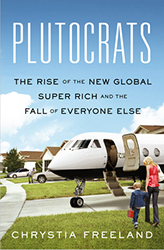Bill recently interviewed author Chrystia Freeland on Moyers & Company. Her book, Plutocrats: The Rise of the New Global Super-Rich and the Fall of Everyone Else, was published last week and is the inaugural book in the Moyers Book Club. Read an excerpt:
“The poor enjoy what the rich could not before afford. What were the luxuries have become the necessaries of life. The laborer has now more comforts than the farmer had a few generations ago. The farmer has more luxuries than the landlord had, and is more richly clad and better housed. The landlord has books and pictures rarer and appointments more artistic than the king could then obtain.”— Andrew Carnegie
 Branko Milanovic is an economist at the World Bank. He first became interested in income inequality studying for his PhD in the 1980s in his native Yugoslavia, where he discovered it was officially viewed as a “sensitive” subject — which meant one the ruling regime didn’t want its scholars to look at too closely. That wasn’t a huge surprise; after all, the central ideological promise of socialism was to deliver a classless society.
Branko Milanovic is an economist at the World Bank. He first became interested in income inequality studying for his PhD in the 1980s in his native Yugoslavia, where he discovered it was officially viewed as a “sensitive” subject — which meant one the ruling regime didn’t want its scholars to look at too closely. That wasn’t a huge surprise; after all, the central ideological promise of socialism was to deliver a classless society.
But when Milanovic moved to Washington, he discovered a curious thing. Americans were happy to celebrate their super-rich and, at least sometimes, worry about their poor. But putting those two conversations together and talking about economic inequality was pretty much taboo.
“I was once told by the head of a prestigious think tank in Washington, D.C., that the think tank’s board was very unlikely to fund any work that had income or wealth inequality in its title,” Milanovic, who wears a beard and has a receding hairline and teddy bear build, explained in a recent book. “Yes, they would finance anything to do with poverty alleviation, but inequality was an altogether different matter.”
“Why?” he asked. “Because ‘my’ concern with the poverty of some people actually projects me in a very nice, warm glow: I am ready to use my money to help them. Charity is a good thing; a lot of egos are boosted by it and many ethical points earned even when only tiny amounts are given to the poor. But inequality is different: Every mention of it raises in fact the issue of the appropriateness or legitimacy of my income.”
Robert Kenny, a Boston psychologist who specializes in counseling the super-elite, agrees. He told an interviewer that “often the word ‘rich’ becomes a pejorative. It rhymes with ‘bitch.’ I’ve been in rooms and seen people stand up and say, ‘I’m Bob Kenny and I’m rich.’ And then they burst into tears.”
It is not just the super-rich who don’t like to talk about rising income inequality. It can be an ideologically uncomfortable conversation for many of the rest of us, too. That’s because even — or perhaps particularly — in the view of its most ardent supporters, global capitalism wasn’t supposed to work quite this way.
This view of the relationship between economic development and income inequality was first and most clearly articulated by Simon Kuznets, a Belarusian-born immigrant to the United States. Kuznets illustrated his theory with one of the most famous graphs in economics — the Kuznets curve, an upside-down U that traces the movement of society as its economy becomes more sophisticated and productive, from low inequality, to high inequality, and back down to low inequality.
Writing in the early years of the industrial revolution, and without the benefit of Kuznets’s data and statistical analysis, Alexis de Tocqueville came up with a similar prediction: “If one looks closely at what has happened to the world since the beginning of society, it is easy to see that equality is prevalent only at the historical poles of civilization. Savages are equal because they are equally weak and ignorant. Very civilized men can all become equal because they all have at their disposal similar means of attaining comfort and happiness. Between these two extremes is found inequality of condition, wealth, knowledge — the power of the few, the poverty, ignorance, and weakness of the rest.”
If you believe in capitalism — and nowadays pretty much the whole world does — the Kuznets curve was a wonderful theory. Economic progress might be brutal and bumpy and create losers along the way. But once we reached that Tocquevillian plateau of all being “very civilized men” (yes, men!), we would all share in the gains. Until the late 1970s, the United States, the world’s poster child of capitalism, was also an embodiment of the Kuznets curve. The great postwar expansion was also the period of what economists have dubbed the Great Compression, when inequality shrank and most Americans came to think of themselves as middle class. This was the era when, in the words of Harvard economist Larry Katz, “Americans grew together.” That seemed to be the natural shape of industrial capitalism.


